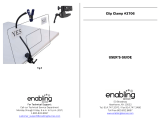
Back
3
Understanding these instructions
English
The original instructions presented in this operators guide were written in English, and subsequently translated
into other languages. If you are unable to understand these instructions, contact Vinten or your distributor to
obtain a translation of the original instructions (EU Countries).
БЪЛГАРСКИ
Оригиналните инструкции, представени в настоящото ръководство на производителя, бяха написани на
английски език, а след това - преведени на други езици. Ако не разбирате тези езици, свържете се с
Vinten или с Вашия дистрибутор, за да получите оригиналните инструкции (за страните от Европейския
съюз).
Česky
Pokyny uvedené v této operátorské příručce byly původně napsány anglicky a následně byly přelo_eny do
ostatních jazyků. Nerozumíte-li těmto pokynům, kontaktujte společnost Vinten nebo svého distributora, abyste
získali překlad originálních pokynů (členské státy EU).
Danish
De originale instruktioner, der præsenteres i denne betjeningsvejledning, er skrevet på engelsk og derefter
oversat til andre sprog. Hvis du ikke forstår disse instruktioner bedes du kontakte Vinten eller vor forhandler for
at få en oversættelse af de originale instruktioner (EU-lande).
Deutsch
Die Originalanleitung in diesem Bedienungshandbuch wurde auf Englisch verfasst und anschließend in andere
Sprachen übersetzt. Bei Verständnisproblemen in einer der übersetzten Sprachen kontaktieren Sie bitte Vinten
oder Ihren Fachhändler; dort erhalten Sie eine Übersetzung der ursprünglichen Anleitung (EU-Staaten).
Eesti
Käesoleva kasutajajuhendi algtekst on koostatud inglise keeles ning seejärel tõlgitud teistesse keeltesse. Kui
juhend osutub teie jaoks arusaamatuks, võtke juhendi emakeelse tõlke hankimiseks ühendust Vinteni või
kohaliku esindajaga (Euroopa Liidu riigid).
Ελληνικά
Οι αρχικές οδηγίες αυτού του οδηγού για το χειριστή συντάχθηκαν στα Αγγλικά και μεταφράστηκαν στη συνέχεια
σε άλλες γλώσσες. Εάν δυσκολεύεστε να καταλάβετε αυτές τις οδηγίες, επικοινωνήστε με τη Vinten ή το
διανομέα σας για να λάβετε μια μετάφραση των αρχικών οδηγιών (Χώρες ΕΕ).
Español
Las instrucciones originales que se indican en esta guía del operador se han redactado en inglés y
posteriormente se han traducido a otros idiomas. Si no entiende estas instrucciones, póngase en contacto con
Vinten o con su distribuidor para obtener una traducción de las instrucciones originales (para países de la UE).
Français
Les instructions originales présentées dans ce guide d'utilisation ont été écrites en anglais puis traduites dans
d'autres langues. Si vous ne comprenez pas ces instructions, contactez Vinten ou votre revendeur pour obtenir
une traduction des instructions originales (pour les pays de l'UE).
























